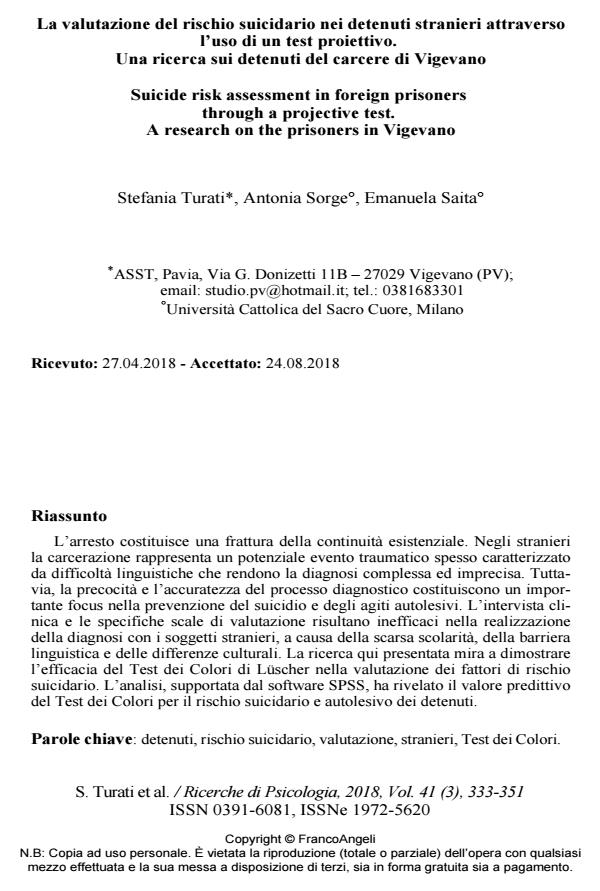Suicide risk assessment in foreign prisoners through a projective test. A research on the prisoners in Vigevano
Journal title RICERCHE DI PSICOLOGIA
Author/s Stefania Turati, Antonia Sorge, Emanuela Saita
Publishing Year 2018 Issue 2018/3
Language Italian Pages 19 P. 333-351 File size 69 KB
DOI 10.3280/RIP2018-003003
DOI is like a bar code for intellectual property: to have more infomation
click here
Below, you can see the article first page
If you want to buy this article in PDF format, you can do it, following the instructions to buy download credits

FrancoAngeli is member of Publishers International Linking Association, Inc (PILA), a not-for-profit association which run the CrossRef service enabling links to and from online scholarly content.
Being arrested constitutes a break in the stream of existence. Among foreigners, incarceration is a potential traumatic event often characterized by language difficulties that make the diagnosis complicated and misleading. However, an early and correct diagnosis process is at the core of prevention and reduction of suicides and self-harming acts. The clinical interview and specific rating scales are inefficient to achieve the diagnosis in foreign subjects because of poor education levels, linguistic barriers and cultural differences. The aim of this research is to show the efficacy of the Lüscher Color Test to evaluate the risk factors for suicide. The analysis, supported by the software SPSS, revealed how the use of the Color test could predict the risk for suicide in inmates.
Keywords: Inmates, suicide risk, assessment, foreigners, Color test.
- Stili di personalità e definizione dei percorsi di cura per pazienti detenuti attraverso l'inventario di Millon Emanuele Truisia, Marco Bani, Francesca Barile, Manuela Valsecchi, Federica Corbetta, Giorgio Rezzonico, Umberto Mazza, in RICERCHE DI PSICOLOGIA 3/2018 pp.353
DOI: 10.3280/RIP2018-003004 - The Framed Portrait Experience: parole e immagini entro i contesti di esecuzione della pena Emanuela Saita, Francesca Anselmi, Serena Ajuti, Roberto Quadraro, in RICERCHE DI PSICOLOGIA 3/2018 pp.439
DOI: 10.3280/RIP2018-003008 - Valutazione e percorsi di trattamento del rischio autolesivo in carcere. L'esperienza nella Casa Circondariale di Monza Manuela Valsecchi, Marco Bani, Francesca Barile, Emanuele Truisi, Michele Monticelli, Gabriele Travagin, Federico Zorzi, Giorgio Rezzonico, Umberto Mazza, in RICERCHE DI PSICOLOGIA 3/2018 pp.307
DOI: 10.3280/RIP2018-003002
Stefania Turati, Antonia Sorge, Emanuela Saita, La valutazione del rischio suicidario nei detenuti stranieri attraverso l’uso di un test proiettivo. Una ricerca sui detenuti del carcere di Vigevano in "RICERCHE DI PSICOLOGIA " 3/2018, pp 333-351, DOI: 10.3280/RIP2018-003003